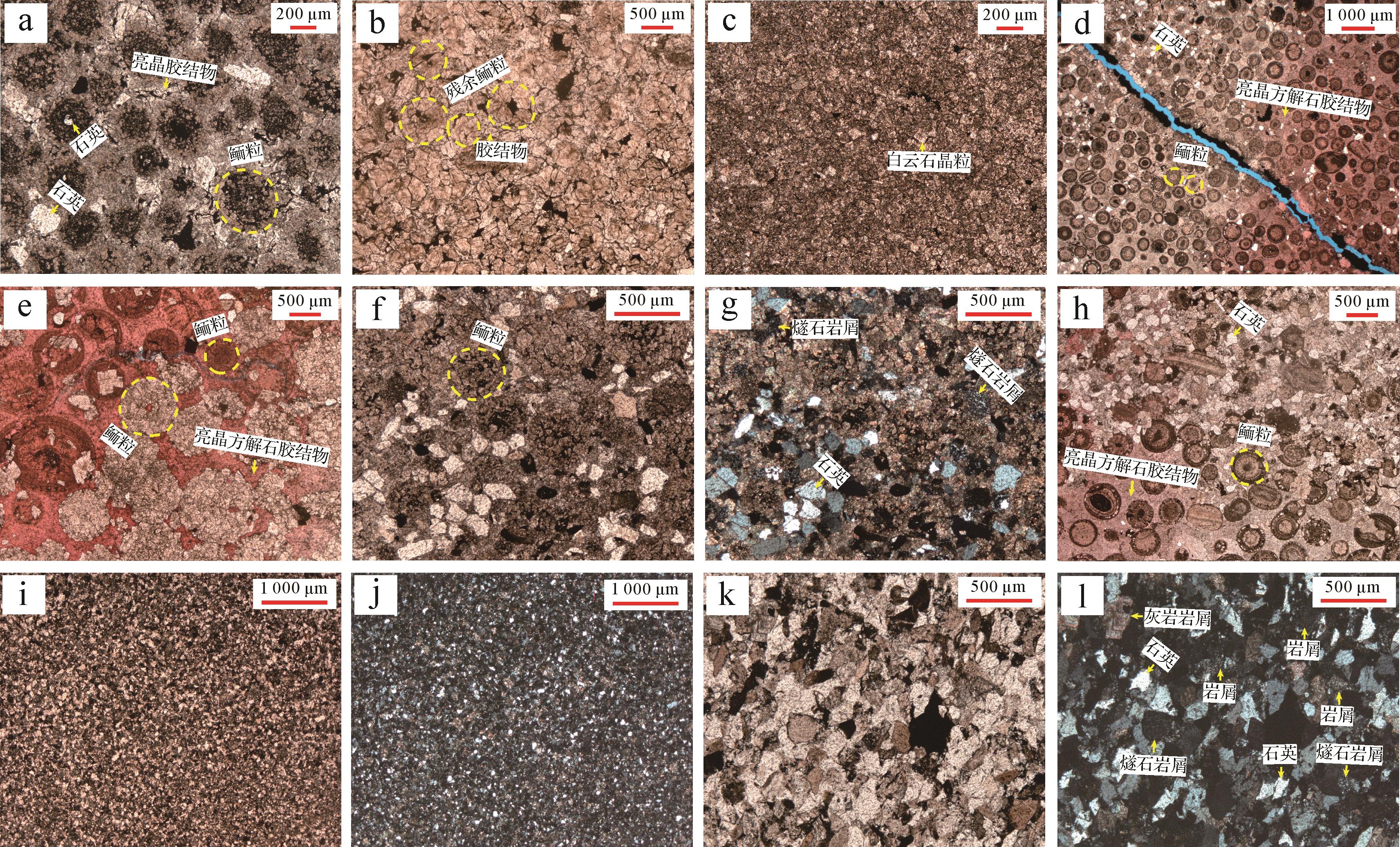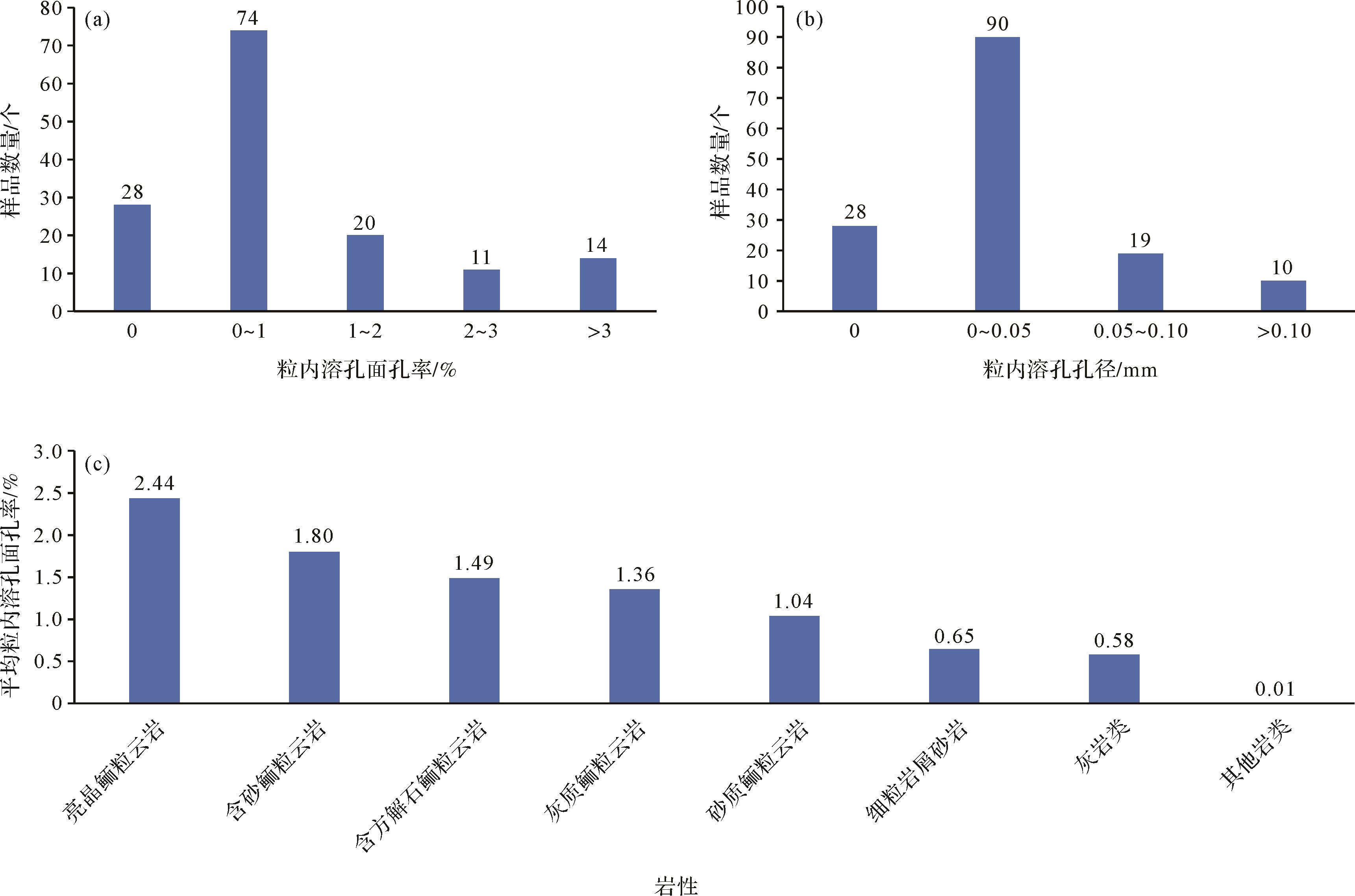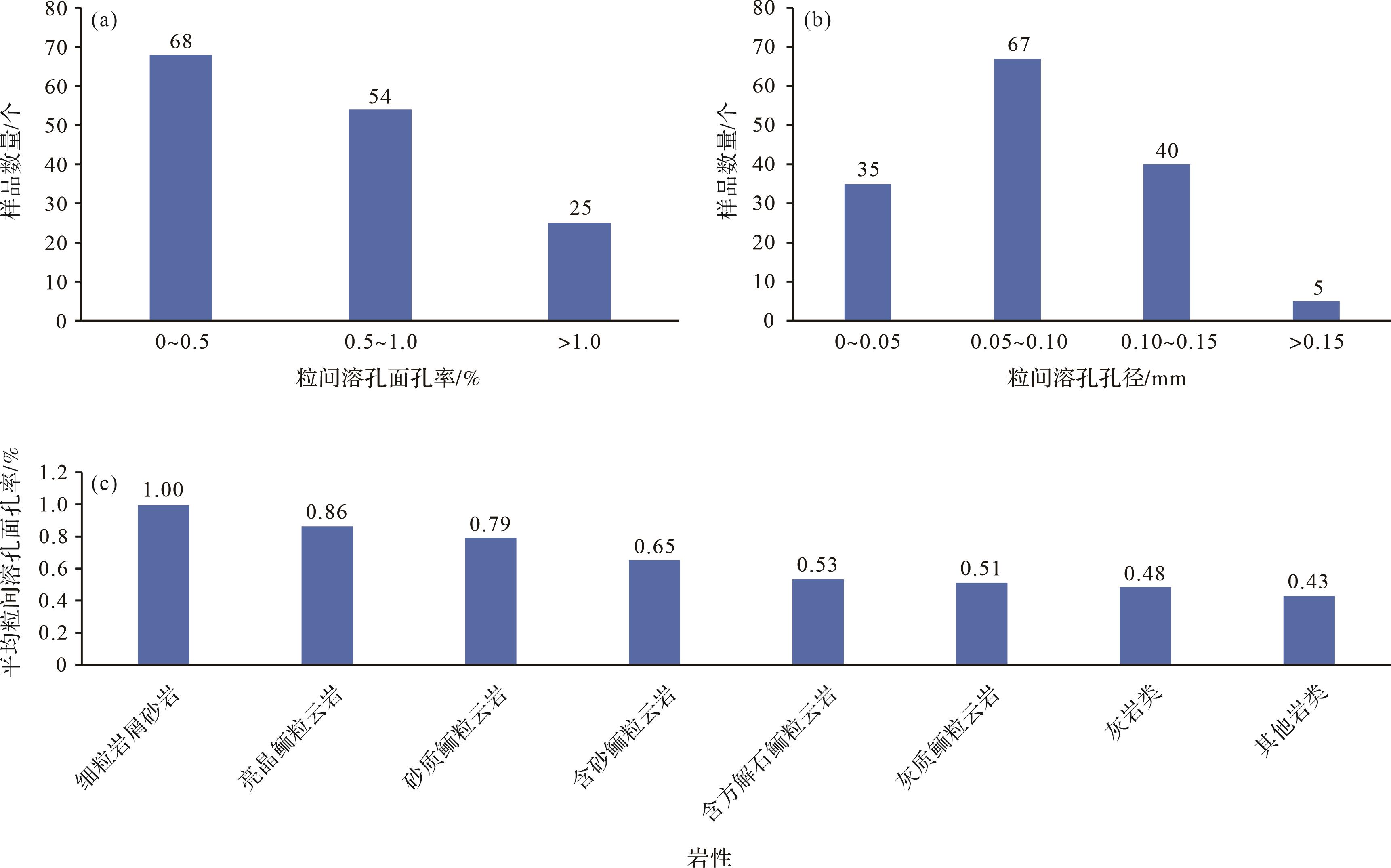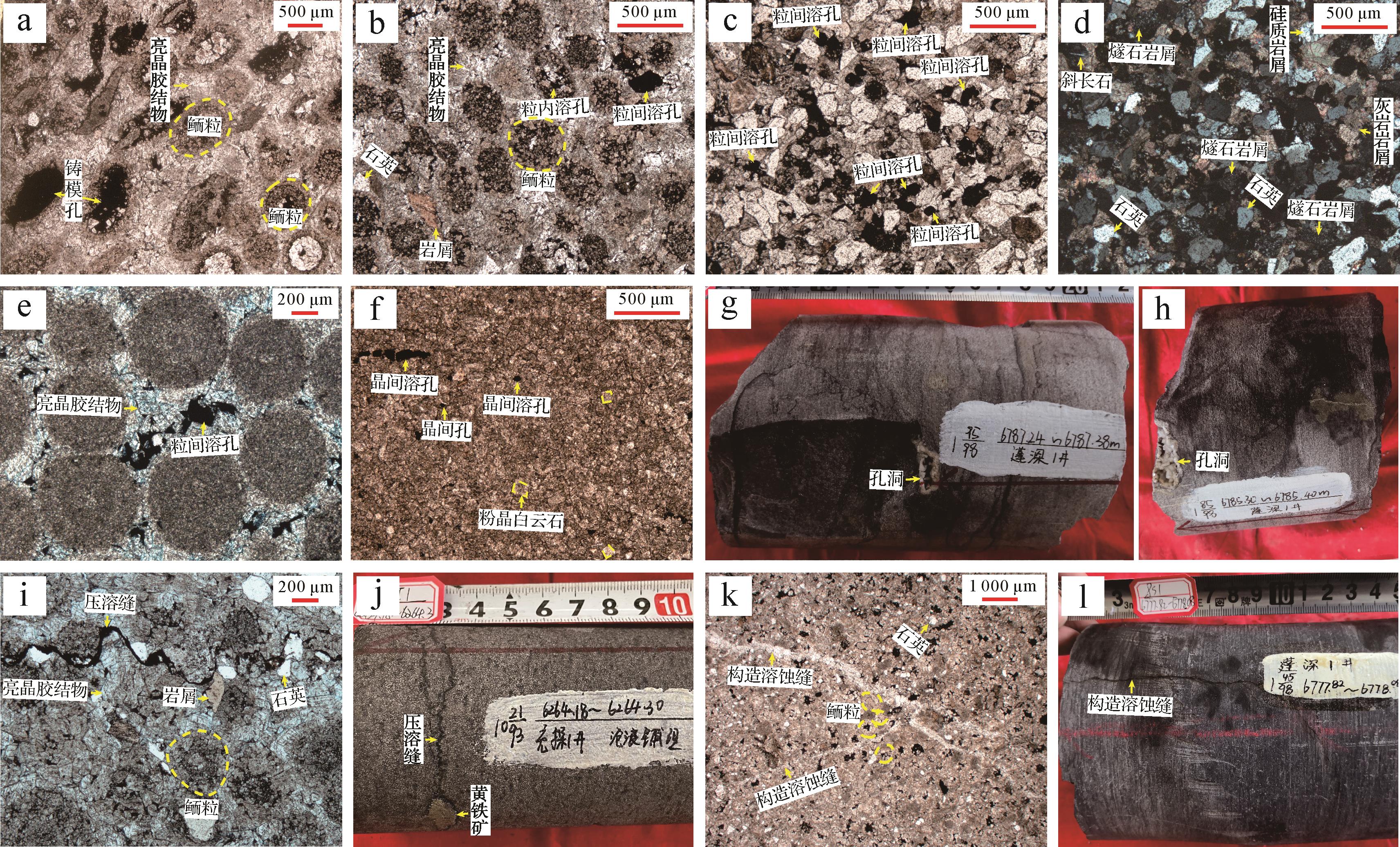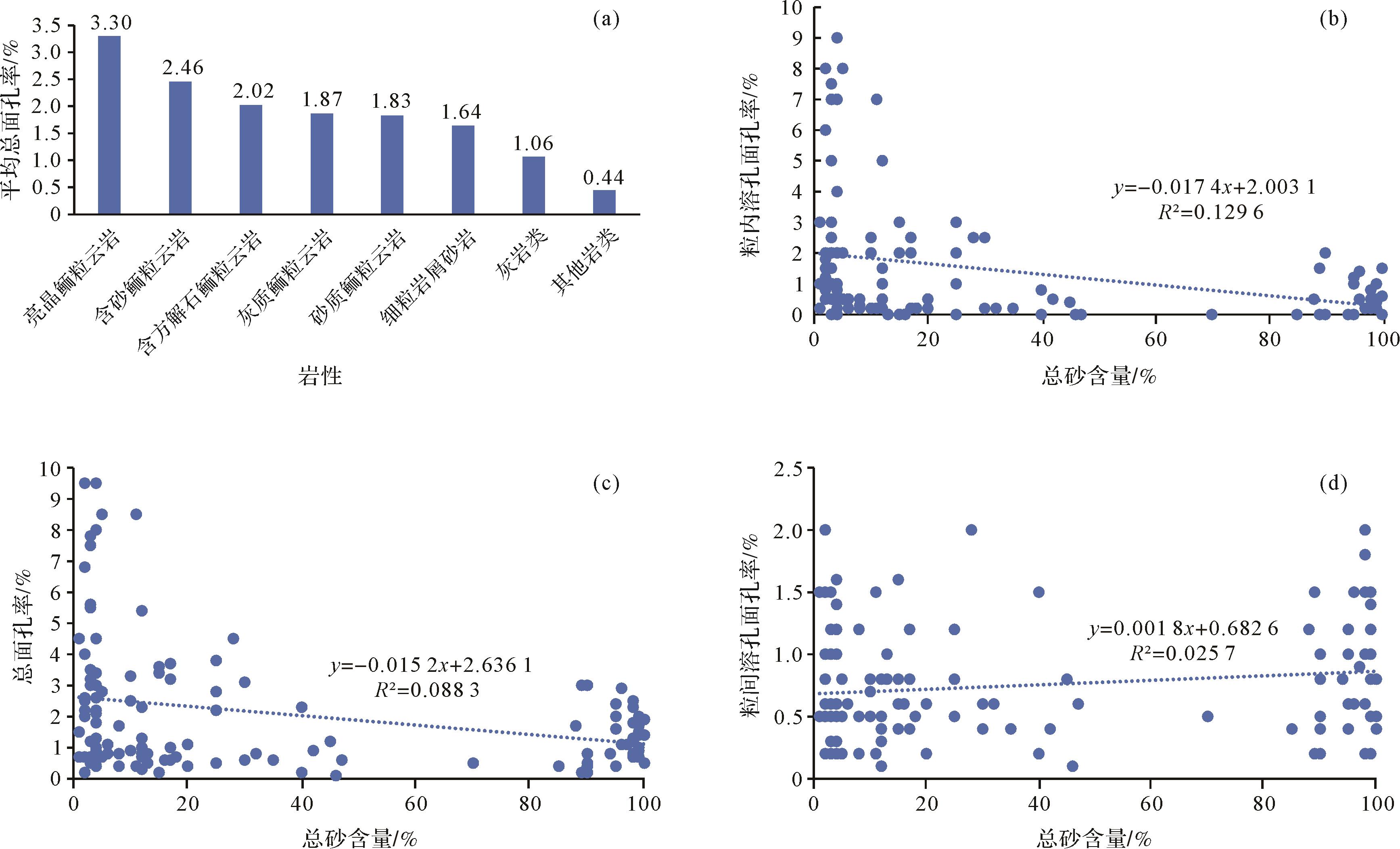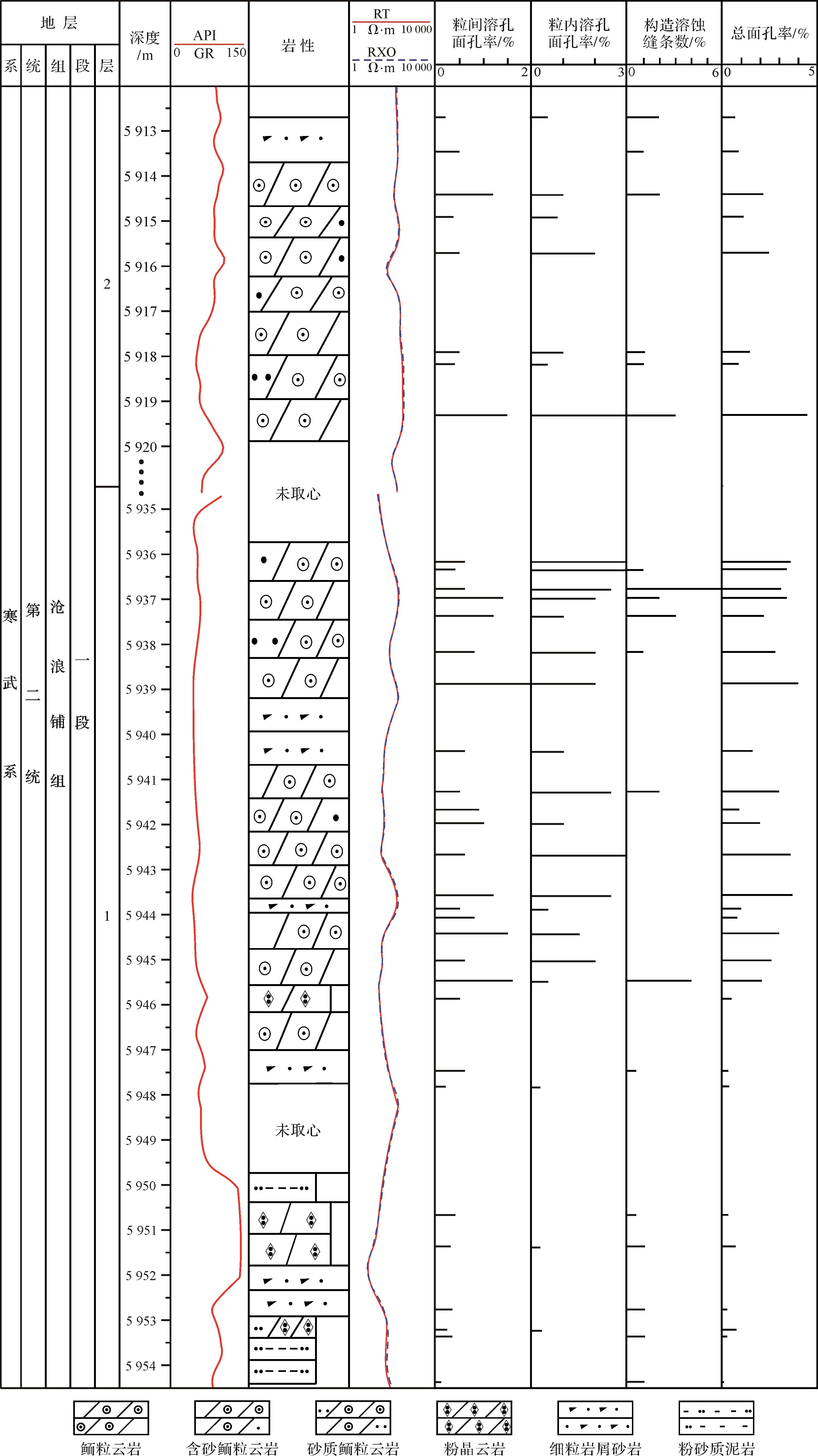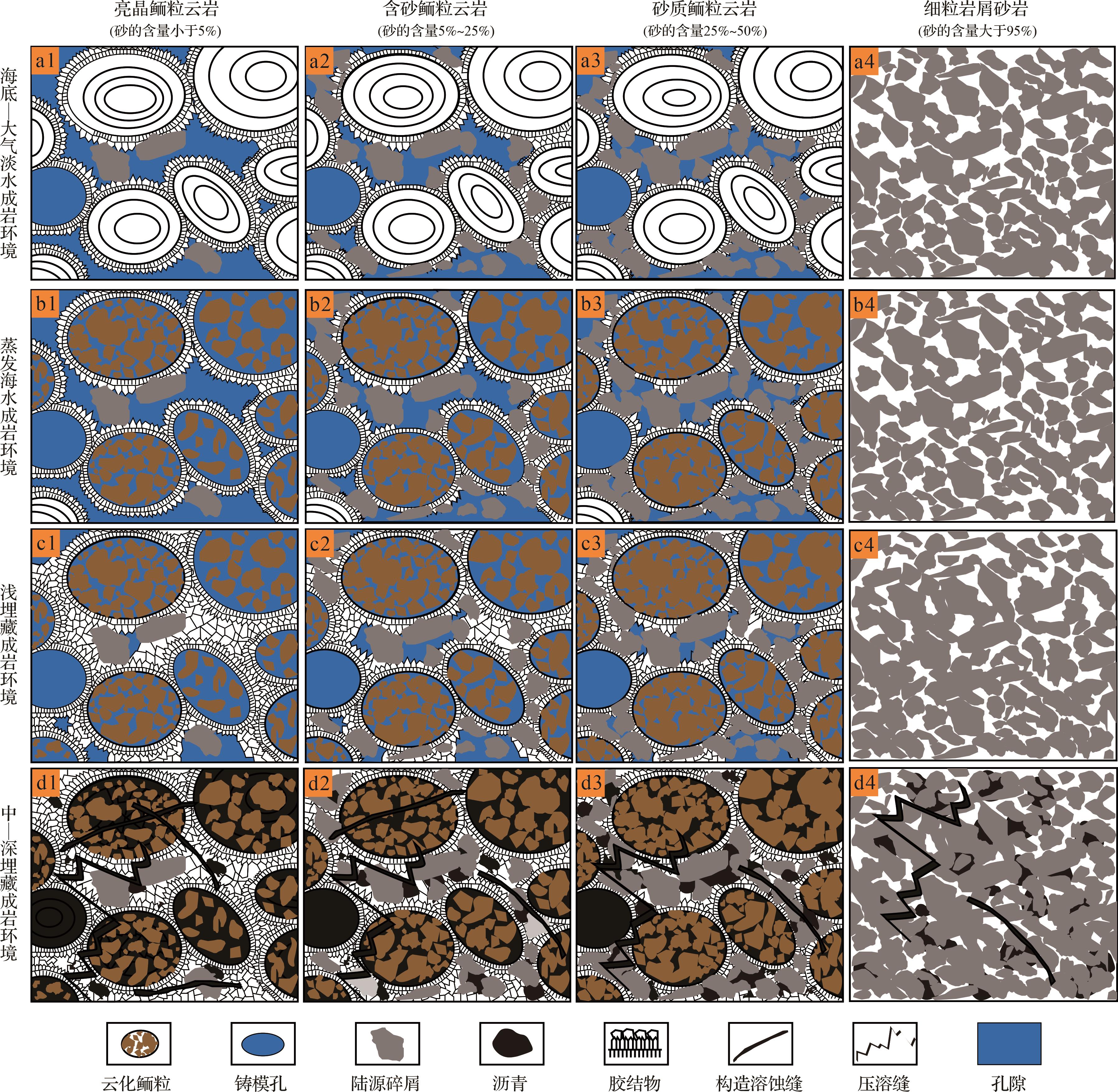HTML
-
震旦系—寒武系第二统是四川盆地中部地区油气勘探的重要领域[1],但目前的勘探开发主要集中在震旦系灯影组和寒武系第二统龙王庙组,整体勘探程度低、勘探层系不均匀[2⁃5]。随着WT1井、CS1井和JT1井在寒武系第二统沧浪铺组钻遇厚层白云岩,尤其是2020年JT1井在沧浪铺组一段测试获得51.62×104 m3/d的工业气流后[1,6],证明了沧浪铺组同样具备巨大的勘探潜力。川中北部地区寒武系第二统沧浪铺组沉积期为海相沉积环境,但受到西部康滇古陆、西北部成灌杂岩体、摩天岭古陆及北部汉江古陆的影响,在下部沧一段形成了以陆源碎屑和碳酸盐等组分相互混合或岩性互层的混合沉积[7]。一些学者将混合沉积分为狭义和广义两类[8⁃10],广义的混合沉积是指同一岩层内陆源碎屑与碳酸盐组分的混合以及碎屑岩与碳酸盐岩构成的互层或夹层的混合。随着油气勘探技术的进步,国内开始针对湖相混合沉积形成的岩石的孔隙特征及成因开展研究,如四川盆地的侏罗系自流井组、准噶尔盆地的二叠系芦草沟组[11⁃15],而针对海相勘探实例的研究报道较少。目前,油气地质学者通过野外露头、测录井、岩心及地震等资料,初步对沧一段的岩性、沉积相、储层地质等方面展开研究[1,6⁃7,16⁃24],但对沧一段的孔隙特征、成因及演化模式研究较少。因此,本文基于岩心段的观察描述、铸体薄片和阴极发光等资料,对沧一段的孔隙特征、成因及演化模式开展系统研究,进而深化对该区储层特征的认识。
-
川中北部地区在构造上位于川中平缓构造区(图1a)。盆地寒武系第二统沧浪铺组俗称“下红层”[3],研究区在四川盆地寒武系地层分区图上属于川西—川中地层小区,前人在对四川盆地标准地层划分时,将川西—川中地层小区的寒武系第二统自下而上依次划分为筇竹寺组、沧浪铺组、龙王庙组、陡坡寺组和洗象池群[26]。沧浪铺组根据岩性或岩性组合特征自下而上分为沧一段和沧二段。震旦纪—早寒武世笻竹寺期,四川盆地西部发育一条贯穿南北的德阳—安岳裂陷槽[27⁃30],至沧一段沉积期,裂陷槽在被填平的过程中逐渐演化为棚内洼地,同时受陆源碎屑物质的影响,形成了一套广义的混合沉积岩;沧二段沉积期,棚内洼地基本被填平,以陆源碎屑岩沉积为主[7](图1b,c)。
-
沧浪铺组一段岩石类型有碳酸盐岩类、混积岩类和碎屑岩类,其中以混积岩类和碳酸盐岩中的白云岩类为主,发育的多种岩性中又以含砂(砂质)鲕粒云岩和亮晶鲕粒云岩最为常见。
-
研究区碳酸盐岩类是陆源碎屑含量小于5.00%的碳酸盐岩,主要包括白云岩类和少量的石灰岩类。云岩类以亮晶鲕粒云岩为主,少量粉晶云岩和灰质鲕粒云岩;鲕粒云岩因白云石化作用强烈,鲕粒内部出现粉—细晶的交代白云石呈点(线)接触或直接交代成为残余鲕粒或多晶鲕,使得粒内溶孔发育(图2a,b);粉晶云岩晶粒晶形较好,多呈菱形,相互镶嵌在一起,为晶粒结构,孔隙不发育(图2c)。灰岩类为少量的亮晶鲕粒灰岩、泥晶灰岩和云质鲕粒灰岩,鲕粒之间多被亮晶方解石一期或两期全充填,溶孔不发育(图2d,e)。
-
混积岩的分类与命名尚未统一,Mount[31]的分类不够直观,引用较为困难;杨朝青等[32]将碳酸盐组分含量大于25.00%,陆源碎屑含量大于10.00%的混合沉积归为混积岩;董桂玉等[33]将同时含有陆源碎屑和碳酸盐组分的岩石归为混积岩;张雄华[34]将碳酸盐岩组分含量和陆源碎屑含量均介于5.00%~95.00%的混合沉积称为混积岩,再结合“三级命名法”进行命名。
本文结合研究区的现状,采用张雄华的混积岩分类方案,即将碳酸盐岩组分含量和陆源碎屑含量均介于5.00%~95.00%的混合沉积称为混积岩。整体来看,研究区的混积岩以混积的碳酸盐岩为主,根据陆源碎屑组分的含量差异分为含陆源碎屑的碳酸盐岩(陆源碎屑组分含量介于5.00%~25.00%,碳酸盐组分含量介于75.00%~95.00%)和陆源碎屑质碳酸盐岩(陆源碎屑组分含量介于25.00%~50.00%,碳酸盐组分含量介于50.00%~75.00%),主要包括含砂鲕粒云岩、砂质鲕粒云岩以及少量的含砂鲕粒灰岩和砂质鲕粒灰岩,陆源石英、岩屑和少量的长石多分布在鲕粒之间,少量陆源石英作为鲕粒的核心。混积的鲕粒云岩粒内溶孔较为发育(图2f,g),而混积的鲕粒灰岩溶孔则不发育(图2h)。
-
碎屑岩类是陆源碎屑含量大于95.00%的碎屑岩,以细粒岩屑砂岩为主,含少量粉砂岩和粉砂质泥岩;陆源碎屑颗粒主要包括石英和岩屑,少量长石,颗粒间以点接触和线接触为主,少量凹凸接触,细粒岩屑砂岩的粒间溶孔较为发育(图2i~l)。
2.1. 碳酸盐岩类
2.2. 混积岩类
2.3. 碎屑岩类
-
基于川中北部地区沧浪铺组一段岩心样品、铸体薄片的鉴定,发现孔隙主要为粒内溶孔,其次是粒间溶孔,少量晶间孔、晶间溶孔、铸模孔、孔洞和裂缝。通过对取自岩心的147张铸体薄片中各种组分的类型、含量以及不同类型孔隙孔径、面孔率等参数的人工和图像识别,利用ImageJ图像软件获取岩石的面孔率等参数。据此,定量分析发现岩石总面孔率与粒内溶孔的面孔率正相关性最好,其次是粒间溶孔的面孔率(图3a,b)。表明沧一段岩石孔隙主要由粒内溶孔组成,其次是粒间溶孔,与铸体薄片鉴定结果一致。
-
粒内溶孔是指(碎屑)颗粒的内部被溶蚀而形成的次生孔隙。当(碎屑)颗粒内部遭受强烈的溶解作用时,溶蚀后仅保留了(碎屑)颗粒的外形轮廓,则形成铸模孔。研究区沧一段粒内溶孔主要发育在亮晶鲕粒云岩、含砂鲕粒云岩和砂质鲕粒云岩中。粒内溶孔孔径介于0~0.50 mm,主要介于0~0.05 mm,约占总孔隙数量的61.20%;面孔率介于0~9.00%,主要介于0.50%~3.00%(图4a,b);而铸模孔发育较少,仅在个别薄片中存在,该孔孔径约1.00 mm,主要分布在鲕粒内部。粒内溶孔受砂的含量和白云石化作用的影响较大,在亮晶鲕粒云岩、含砂鲕粒云岩和砂质鲕粒云岩中平均粒内溶孔面孔率分别约2.44%、1.80%和1.04%;在细粒岩屑砂岩和灰岩中发育较少,平均粒内溶孔面孔率分别约0.65%和0.58%;而在其他岩性中,如泥岩和粉砂岩中粒内溶孔平均面孔率更低(图4c)。因此,粒内溶孔受砂的含量及白云石化作用的影响较大,在岩石中的发育程度为亮晶鲕粒云岩>含砂的鲕粒云岩>砂质鲕粒云岩>细粒岩屑砂岩>灰岩等,孔隙多被沥青全充填(图2a,f)。
-
粒间溶孔是指分布于(碎屑)颗粒之间,遭受溶蚀作用而形成的孔隙。研究区粒间溶孔主要发育在细粒岩屑砂岩、砂质鲕粒云岩、含砂鲕粒云岩和亮晶鲕粒云岩中;孔径介于0.01~0.25 mm,主要介于0.05~0.15 mm,约占总孔隙数量的72.70%;面孔率介于0~2.00%,主要介于0~1.00%(图5a,b)。在细粒岩屑砂岩、亮晶鲕粒云岩、砂质鲕粒云岩和含砂鲕粒云岩中平均粒间溶孔面孔率分别约1.00%、0.86%、0.79%和0.65%,而在灰岩和其他岩中平均粒间溶孔面孔率介于0.40%~0.50%(图5c)。根据上述特征发现,粒间溶孔的面孔率变化较小,在岩石中的发育程度为细粒岩屑砂岩>亮晶鲕粒云岩>砂质鲕粒云岩>含砂的鲕粒云岩>灰岩等,且该溶孔多被沥青和交代白云石或胶结白云石全充填(图6c~e)。
-
其他类型的孔隙主要包括含量极少的孔洞、晶间孔和晶间溶孔,其中孔洞仅在岩心中可见。
晶间孔是指分布在矿物晶体之间且未遭受后期成岩作用改造而保存下来的孔隙;该孔孔径主要介于0.01~0.06 mm,呈方形或菱形,边界较为平整(图6f)。
晶间溶孔是指在晶间孔的基础上溶蚀扩大或在晶粒接触处重新溶蚀形成的孔隙;该孔孔径介于0.01~0.25 mm,主要介于0.04~0.06 mm,边界因溶蚀作用而不平整,形状不规则(图6f)。
孔洞是指岩石组分被溶解而形成孔径大于2.00 mm的孔隙,研究区孔洞的孔径介于1.00~5.00 cm,被方解石或白云石半充填—全充填。通过对研究区沧浪铺组一段已有岩心的观察发现,孔洞整体发育少,且多为孤立的不规则状(图6g,h)。
-
研究区裂缝主要为压溶缝和构造溶蚀缝。压溶缝是指岩石在巨大的压力作用下,(碎屑)颗粒接触处发生溶解而形成的锯齿状裂缝;缝宽0.01~0.05 mm,主要介于0.01~0.02 mm,大多贯穿整个岩石薄片且多被沥青全充填,少量未充填,边缘多呈锯齿状或弯曲状,边界极不规则(图6i,j),在各类岩石中均有分布。
构造溶蚀缝是指岩石受构造应力的影响,破裂产生构造缝,之后被酸性流体溶蚀扩宽形成构造溶蚀缝。构造溶蚀缝的缝宽主要介于0.01~0.02 mm,薄片中该缝的长度主要介于5.00~6.00 mm,少量贯穿整个薄片,多被沥青或白云石全充填,少量未被充填,边界较为规则(图6k,l)。
3.1. 粒内溶孔
3.2. 粒间溶孔
3.3. 其他类型的孔隙
3.4. 裂缝
-
有利的沉积微相是孔隙发育的基础,往往在高能滩相环境中沉积的岩石,其孔隙发育较好,而在低能的沉积环境中沉积的岩石,其孔隙均欠发育。因为高能的沉积环境通常处于浪基面之上,受波浪淘洗作用强,沉积的岩石组分多以(碎屑)颗粒为主,且(碎屑)颗粒质地纯净,粒径大而均匀,能够形成很好的原生孔隙;同时,粒间多以亮晶胶结物为主,有利于后期成岩作用的改造,从而有利于孔隙的发育和保存。而在低能的沉积环境,沉积物粒度细且粒间以泥晶充填为主,不利于原生孔隙的发育和后期成岩作用的改造。
根据研究区沧浪铺组一段的岩石类型、岩石组合特征以及前人的研究[7,19,24],综合认为沧浪铺组一段的沉积环境主要为陆棚相,包括清水浅水陆棚亚相、混积浅水陆棚亚相、碎屑浅水陆棚亚相和深水陆棚亚相,其中亮晶鲕粒云岩和含砂鲕粒云岩、砂质鲕粒云岩分别形成于清水浅水陆棚亚相和混积浅水陆棚亚相的高能鲕粒滩微相,水体能量高,岩石颗粒粗且均匀,有利于岩石孔隙发育(图2a,f、图6a,e)。而在低能的陆棚相中沉积的泥晶灰岩、粉砂岩、粉晶云岩、泥岩等孔隙极不发育(图2c,i),其沉积环境水体能量低,沉积物颗粒细,原生孔隙不发育,也不利于后期成岩作用的改造。因此,高能陆棚相—清水(混积)浅水陆棚相亚相—鲕粒滩微相为研究区沧浪铺组一段的有利沉积相带,有利于岩石孔隙的发育。
-
研究区沧浪铺组一段的岩石不仅有鲕粒、胶结物、晶粒等碳酸盐组分,还有砂级的石英、长石、岩屑等为主的陆源碎屑组分。不同组分形成的各种岩性中,孔隙发育程度的排序为亮晶鲕粒云岩、含砂鲕粒云岩、砂质鲕粒云岩、细粒岩屑砂岩、石灰岩类等(图7a)。目前沧一段岩心主要的岩性为含砂(砂质)鲕粒云岩和亮晶鲕粒云岩,除了亮晶胶结物外,陆源砂与鲕粒是主要的组分,二者的含量呈“此消彼长”的特点。所以,本文选用其中之一的陆源砂含量来分析其对孔隙成因的影响。
基于铸体薄片中孔隙参数及岩石组分含量的定量表征,发现含砂量与孔隙发育程度整体呈负相关关系,如岩石总面孔率、粒内溶孔面孔率均与砂的含量呈弱的负相关关系(图7b,c)。这主要是因为陆源砂级碎屑本身不易被溶蚀,其含量增加,相对易于被溶蚀的鲕粒含量则减少,进而会明显降低粒内溶孔的发育,而岩石总面孔率主要由粒内溶孔贡献(图3a,b),故陆源砂的沉积不利于整体孔隙的发育。但是,陆源砂以石英和岩屑为主,岩屑又主要为燧石岩屑等刚性岩屑,两者物理化学性质稳定,硬度大,抗压能力强,对埋藏环境下的粒间孔隙具有保护作用,从而利于酸性流体的流动,可以保持或者增加粒间溶孔的数量、孔径及面孔率[35⁃38]。因此,总含砂量与粒间溶孔存在较弱的正相关性(图7d),并使得镜下观察粒间溶孔整体在细粒岩屑砂岩、砂质鲕粒云岩、含砂鲕粒云岩和亮晶鲕粒云岩发育程度依次降低,即较高鲕粒/陆源砂的含量比例是孔隙发育的重要物质基础。
-
成岩作用主要控制次生孔隙的发育。准同生白云石化作用能够很好地保护原生孔隙[39⁃40],有利于后期酸性流体的流动,促进次生孔隙的发育;埋藏白云石化作用增大岩石孔隙的孔径[41⁃44],促进溶解作用,从而促进孔隙的发育。溶解作用则是次生孔隙形成的关键,在准同生大气淡水成环境中,组构选择性溶解作用主要对未完成稳定化的矿物进行溶蚀,形成大量的粒内溶孔和少量的粒间溶孔、铸模孔、孔洞等;而在埋藏成岩环境中,主要为非组构选择性溶蚀,其对早期的原生或次生孔隙进一步溶蚀扩大。胶结作用、压实作用、压溶作用等则使得孔隙的孔径逐渐减小甚至消失。
镜下观察发现研究区的溶解作用、白云石化作用、胶结作用、压实作用和压溶作用对孔隙的影响较为显著。其中溶解作用是次生孔隙形成的关键,研究区主要为大气淡水环境下组构选择性溶解和埋藏环境下酸性流体运移产生的溶解,前者主要对鲕粒间或鲕粒内部未完成矿物稳定化的高镁方解石、文石等进行选择性溶蚀,形成大量的粒内溶孔、粒间溶孔等(图8a,b),当鲕粒内部被完全溶蚀仅剩外形轮廓时,则形成铸模孔(图6a);后者则主要沿着先期孔隙或裂缝的边缘进一步溶蚀扩大(图8a,b),使得孔隙得到进一步改善。
白云石化作用多发生在准同生期和埋藏期。沧浪铺组早期沉积处于干旱、炎热的古气候环境[45],前人对研究区做了大量的研究得到古盐度经验公式Z=2.048×(δ13C+50)+0.498×(δ18O+50)和古水温经验公式T=16.90-4.20(δ18O校正+0.22)+0.13(δ18O校正+0.22)2[46⁃49]。马腾霄等[50]通过实验获得研究区样品的C、O同位素值,经过计算发现沧浪铺组一段沉积时水体盐度高,古水温温度高,气候炎热,有利于准同生白云石化作用的进行,交代形成的白云石阴极发光不发光—昏暗发光(图8e);进入埋藏环境后,白云石化作用沿着第一期胶结物的边缘进行交代,形成的白云石阴极发光为明亮发光(图8h)。白云石化作用交代形成的白云石在埋藏过程中的抗压能力强[40⁃41],能够减低压实作用对孔隙的影响,从而保护早期的各类孔隙(图8a,b);当埋深超过2 000.00 m时(研究区沧一段埋深均超过5 000.00 m),埋藏白云石化作用会使交代白云石的体积小于被交代方解石的体积,使得固相体积减小,进而增大岩石孔隙的孔径[41⁃44]。沧一段未经历白云石化作用或白云石化作用较弱的灰岩中,其孔隙发育较弱(图4c、图5c),在云化的鲕粒内部可见粒内溶孔(图8i左上部),而在未被云化的部分孔隙极不发育(图8i右下部)。
胶结作用、压实作用和压溶作用使孔隙的孔径逐渐减小甚至消失,对孔隙发育起到消极的影响。其中,海底成岩环境中的胶结作用形成了栉壳状、叶片状等胶结物,围绕颗粒生长;埋藏环境中的胶结作用则在此基础上形成粒状胶结物,进一步充填孔隙(图8j)。压实作用则会使得(碎屑)颗粒之间逐渐靠近,从沉积时的无接触或点接触到沉积后线接触或凹凸接触,孔隙孔径逐渐减少,最终消失;通过镜下观察发现,研究区碎屑岩经历的压实作用普遍比碳酸盐岩强,前者的碎屑颗粒之间主要为线接触和凹凸接触(图8k),后者以无接触和点接触为主,少量线接触(图8a,c,g,j)。压溶作用随着埋藏深度的增加,上覆压力不断增大,岩石矿物在高压应力区(颗粒接触处)发生溶解,通过流体迁移,在低压应力区沉淀,形成压溶缝(图6i,j),进一步破坏孔隙的发育。
-
构造作用对孔隙的影响主要表现在埋藏成岩环境中,早期的松软沉积物固结成岩,在经历强烈构造活动的过程中,当岩石受到的构造应力大于其弹性限度时,岩石就会破碎产生裂缝,而裂缝作为沉积岩良好的疏导通道,能够促进流体的流动,进而促进溶解作用。
通过调研发现,研究区构造运动多发生在晚三叠世之后,晚三叠世—早侏罗世受印支运动的影响,盆地受周缘板块的碰撞作用,边缘构造活动强烈,但研究区位于四川盆地中北部,整体构造作用还是较弱。但是,中侏罗世之后,燕山运动和喜马拉雅运动使得盆地边缘地区向盆内压缩,地层发生褶皱抬升,构造活动强烈[51]。因此,研究区构造作用主要发生在中侏罗世之后,岩石破裂产生构造缝,后期又经历溶蚀作用,形成构造溶蚀缝(图6k,l),而裂缝又有助于后期酸性流体的流动,进一步增加岩石孔隙的孔径及数量,有利于孔隙的发育。
4.1. 沉积微相
4.2. 岩石组分类型及含量
4.3. 成岩作用
4.4. 构造作用
-
通过绘制研究区5口单井的孔隙纵向发育特征柱状图,观察发现岩石的总面孔率整体随深度增加而减低,即总面孔率与深度整体呈负相关关系,本文选取研究区典型井DB1井来表征孔隙的纵向发育特征(图9)。由图9可以观察发现取心段的孔隙主要发育在中部5 945.50~5 936.00 m和中上部5 913.00~5 919.00 m,孔隙类型以粒间溶孔和粒内溶孔为主,两者均较为发育,其中粒内溶孔平均面孔率约1.55%,粒间溶孔平均面孔率约0.89%,平均总面孔率约2.44%;而在中下部5 945.50~5 954.50 m孔隙则欠发育,主要为少量的粒间溶孔和极少量的粒内溶孔,前者平均面孔率约0.37%,后者平均面孔率约0.19%,平均总面孔率约0.56%。引起上述的原因主要包括两方面,一方面,中部和中上部的岩性以鲕粒云岩和细粒岩屑砂岩为主,沉积环境水体能量高,不利于细粒沉积物的沉积,从而使得原生孔隙能够很好地发育,促进后期成岩作用的改造;而中下部的岩性以粉晶云岩和粉砂质泥岩为主,夹少量的细粒岩屑砂岩,沉积颗粒细,原生孔隙不发育,也不利于后期成岩作用的改造,从而使得如今的孔隙不发育。另一方面,随着深度的增加,上覆沉积物的厚度不断增厚,上覆压力不断增加,岩石的孔隙孔径逐渐减小甚至消失,从而深度增加,不利于岩石孔隙的发育和保存。
-
综上所述,研究区沧浪铺组一段的孔隙主要受岩石组分类型及含量、成岩作用和构造作用的影响。在正常海底成岩环境中,孔隙主要受胶结作用的影响,针状、纤维状方解石绕着鲕粒的边缘胶结(图8j),使得原生粒间孔的孔径逐渐变小(图10a1~a3);而研究区西部以陆源碎屑岩为主,沉积物之间难以沉淀胶结物(图10a4)。同生期相对海平面下降时,沉积物暴露在大气淡水成岩环境中,大气水的组构选择性溶解作用于鲕粒的内部或粒间胶结物,形成粒内溶孔、铸模孔及粒间溶孔等(图6a、图8a,b),是沧一段孔隙发育的最有利因素(图10a1~a3);然而,当岩石组分中砂的含量增加,易溶的鲕粒等碳酸盐组分难以沉积、含量则减少,大气淡水对其溶解作用减弱,使得研究区主要的粒内溶孔发育变差(图8k、图10b4)。在蒸发海水成岩环境中,白云石化作用强烈(图10b1~b3),白云石含量增加,岩石抗压能力增强,进入埋藏环境后能更好地保护先期孔隙。在浅埋藏及中—深埋藏的成岩环境中,孔隙受压实作用、压溶作用、胶结作用等影响,各种岩性的孔隙孔径减小或被充填,但含砂(砂质)鲕粒云岩、亮晶鲕粒云岩等经历了准同生期白云石化作用而具有一定的抗压性,加上埋藏期白云石化的增孔效应、溶解作用及构造作用形成的裂缝,使得这两种岩性孔隙较发育,常被油气运移后形成的沥青质充填(图10c1~c3,d1~d3)。随着陆源砂含量的增加,石英及刚性岩屑等组分可以增强岩石抗压性,在一定程度上可以保护残余粒间溶孔或利于酸性流体在粒间流动进而发生溶解作用,故粒间溶孔在细粒岩屑砂岩中较为常见(图6c、图10d4)。但是,陆源砂含量增加,鲕粒等碳酸盐组分含量则减少,各期溶解作用和白云石化作用等对孔隙有利的成岩作用难以发生,粒内溶孔不发育,使得总体孔隙较鲕粒白云岩、混积岩中的含砂/砂质鲕粒云岩等发育差。因此,岩石组分中的鲕粒、溶解作用、白云石化作用及构造破裂作用有利于沧浪铺组一段孔隙的发育,陆源砂、胶结作用、压实作用和压溶作用整体上不利于孔隙的发育。
5.1. 纵向发育特征
5.2. 孔隙演化模式
-
(1) 沧浪铺组一段的孔隙主要为鲕粒的粒内溶孔,其次为粒间溶孔,少量晶间(溶)孔、孔洞及裂缝。粒内溶孔主要发育在亮晶鲕粒云岩和含砂(砂质)鲕粒云岩中,孔径主要介于0~0.05 mm,面孔率主要介于0.50%~3.00%。粒间溶孔主要发育在细粒岩屑砂岩、亮晶鲕粒云岩和含砂(砂质)鲕粒云岩中,孔径主要介于0.05~0.15 mm,面孔率主要介于0~1.00%。
(2) 沧一段孔隙的发育主要受沉积微相、岩石中较高的鲕粒/陆源砂的含量比例、溶解作用、白云石化作用和构造作用的综合影响,并形成各岩性孔隙面孔率依次降低的顺序:亮晶鲕粒云岩、含砂鲕粒云岩、砂质鲕粒云岩、细粒岩屑砂岩、石灰岩类。高能的陆棚鲕粒滩微相是原生孔隙发育的主控因素;鲕粒含量增加、陆源砂的含量减少,是有利于孔隙发育的成岩—构造作用的物质基础;溶解作用是孔隙发育的最有利因素,同生期大气水选择性溶蚀形成沧一段最主要的鲕粒粒内溶孔,而埋藏期溶解作用则沿着构造破裂形成的裂缝和早期孔隙进行溶解扩大;白云石化作用则增强岩石的抗压性、使固相体积缩小而增加孔隙;胶结作用、压实作用和压溶作用则是对各岩性孔隙均不利的因素。

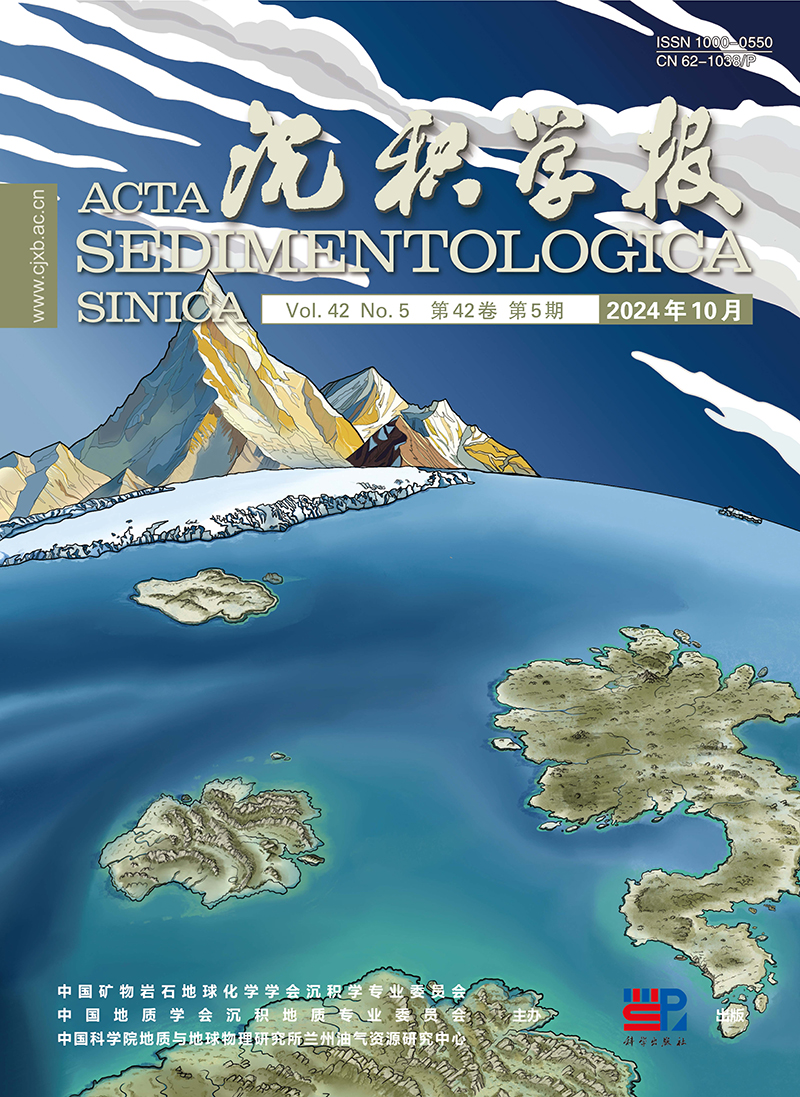


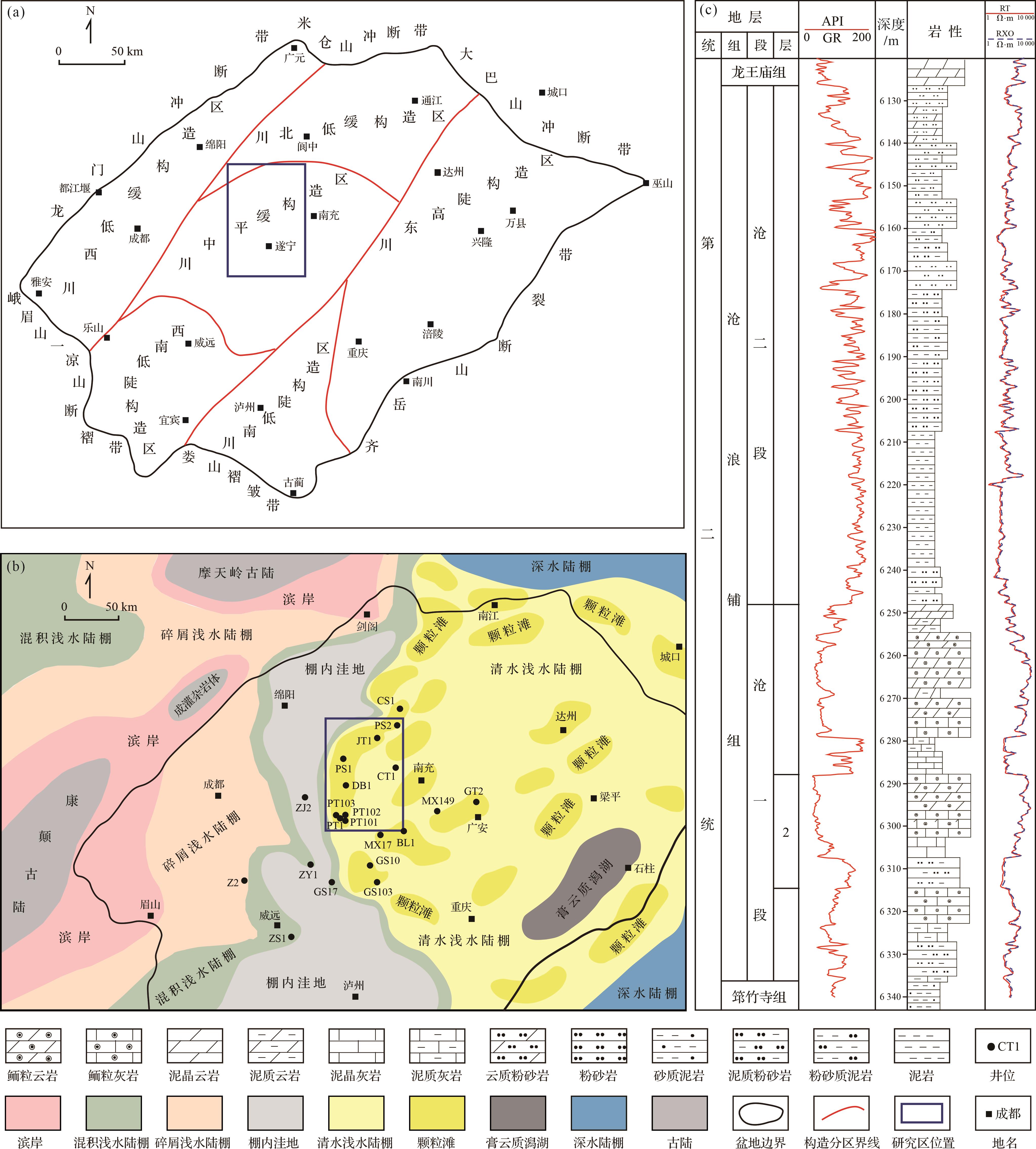












 DownLoad:
DownLoad:
